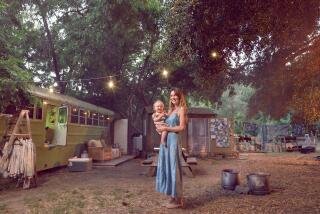Loving the Land That Engulfed Him : New Interest in Young Man Who Vanished 53 Years Ago
May many another youth be by me inspired to leave the smug safety of his rut and follow fortune to other lands.
--Everett Ruess, writing at age 19
Amid the arrests and auto thefts reported in the Los Angeles Police Department bulletin for Sept. 4, 1935, one item seems out of place. It’s too romantic, too mysterious to belong on a police ledger. It seems better suited to a novel by Zane Grey:
A Los Angeles youth leaves his family’s home to paint landscapes and explore Indian caves and cliff dwellings in southern Utah. The boy befriends Indians in remote villages and learns to walk like an Indian, and to speak the Navajo language. He travels with a couple of burros whose saddlebags are decorated with colorful Indian designs.
The Lone Clue
Then the boy vanishes. He is seen last by a sheepherder on Nov. 19, 1934. Four months later his burros are found in a place called Davis Gulch. A lone clue to the mysterious disappearance of Everett Ruess is the word NEMO, scratched on the cliffs alongside Indian pictographs near where the burros were discovered.
Nemo, as adventure fans know, is the name of the captain in Jules Verne’s “Twenty Thousand Leagues Under the Sea,” a favorite novel of Ruess’. Nemo, Latin for “no one,” escaped humdrum civilization in a submarine.
And fleeing civilization is just what the missing boy seemed to have done. Nothing has ever been found of him but his burros and a couple of dusty footprints.
The police bulletin has yellowed in the last half century, but Everett Ruess’ story has acquired new life. Ruess’ older brother, Waldo, who lives in Santa Barbara with his wife of 29 years, said that Everett’s name is becoming legend in the West. Waldo Ruess, 77, has heard many accounts of people who have been inspired to adventures of their own after hearing the tale of Everett Ruess.
Solo Wilderness Journey
A 26-year-old Fort Collins, Colo., college student, Judy Perkins, is currently on a year’s solo wilderness journey, following the route of Ruess. New Mexico writer Marc Simmons also set out to explore the Utah canyon country on a long-earred burro named Taco after reading Ruess’ letters home.
The letters were recently published by Peregrine Smith Books in a volume called “Everett Ruess: A Vagabond for Beauty.” (The $9.95 paperback is available in bookstores or from the publisher at P.O. Box 667, Layton, Utah 84041.) Peregrine president Gibbs Smith said that many readers have written to say how much Ruess means to them.
What accounts for the growing popularity of this long-vanished youth? “He kept his dream,” Waldo Ruess said. “Most of us go lock-step through the decades, talking about what we’d like to do and never doing it.”
Frank Cook of Peregrine Smith Books said Everett Ruess represents “that special spirit which exists in all of us but which few have the courage or opportunity to express.”
Gibbs Smith discovered Ruess’ writing in a 1940 volume, “On Desert Trails,” that has been long out of print. Smith, along with veteran river-runner Ken Sleight and W. L. Rusho, who compiled the recent edition of letters, pieced together Ruess’ story by visiting the towns and campsites he had written about.
Sleight, who lives in Escalante, Utah, said Ruess’ tale has been told around campfires for 50 years. Sleight first heard the saga from an old river-runner, and has since passed on the mystery to tourists who ride the rapids with him. Sleight said he identifies with Ruess’ “wanting to be out, to escape from civilization.
“Those that I meet down on the river and the trails, they all know the story of Everett Ruess,” he said. “And no doubt about it, there are still a lot of people looking for him.”
Different Stories
There is little agreement about what happened to Everett Ruess. Waldo Ruess thinks his brother was killed by cattle rustlers who were known to hide out in the canyons. Sleight thinks he might have drowned while trying to cross a river on his way to rendezvous with a Navajo girlfriend. Others think he fell off a cliff and was killed--although this is unlikely since neither his body nor his paints and other supplies were ever found.
Still others--those people Sleight refers to who are still looking for Ruess--think he didn’t die, but disappeared intentionally. His letters are studded with references to disappearance. The message is so clear that it’s difficult to dismiss it as a young man’s tendency toward melodrama--which Ruess certainly was guilty of at times. There are numerous passages like this one:
I must pack my short life full of interesting events and creative activity. Then, and before physical deterioration obtrudes, I shall go on some last wilderness trip to a place I have known and loved. I shall not return.
Ruess’ life and letters seem calculated; it’s almost as if he intended to serve as an example to anyone who’s ever felt trapped or bored by routine. By disappearing, he might have wanted to ensure that his bold image would never grow old or ordinary. In his letters to his family in Los Angeles, he was constantly goading them to consider if they could say, as he did, “I have really lived.”
He swore that he would follow beauty no matter what it cost: “I have gone my way regardless of everything but beauty.”
It was a value learned from his mother, formerly an art teacher in the Alhambra city schools and the daughter of an early California pioneer, William Henry Knight. Stella Knight Ruess was an artist and poet who published several books of block prints depicting Southern California scenes.
His father, Christopher Ruess, was more prosaic. At the time Everett vanished, his father was working for the Los Angeles County Probation Department.
Encouraged His Travels
But the Ruess family respected art and intellectual activity. So no one objected when Everett first set out to find subjects for his painting at the age of 16. In fact, the family encouraged his travels and sent him money when they could. In return, Everett penned elaborate accounts of his adventures.
On one trip, up the coast to Carmel, he reported that he had met the photographer Edward Weston and played with Weston’s young sons. Later he would show his block prints to another photographer, Ansel Adams, and spend time at the home of landscape painter Maynard Dixon and his wife, photographer Dorothea Lange. (Lange took the photograph of Everett that appeared on the LAPD police bulletin.)
Everett Ruess wasn’t around long enough for his art or his writing to mature. But many believe that if he had lived, his words would have been the thing to bring him fame. His descriptions of the wilderness have earned him comparisons to a young Walt Whitman or John Muir.
Gibbs Smith extols Ruess’ skill as an environmental writer and early defender of the fragile canyon lands. “Everett Ruess said it better than anybody else regarding this land’s spiritual and aesthetic values.”
At UCLA for One Semester
From the age of 16 to 20, when he vanished, he spent most of his time wandering in the wilderness alone. He sang opera to his burros, read philosophy and tried to describe the beauty he saw around him. He made occasional trips to the city, spending time in San Francisco and with his family in Los Angeles--he even enrolled in UCLA for one semester in 1932. “I’m glad I went, but I’m glad it’s over,” he wrote a friend.
It was in the canyon country of Utah and Arizona, a land of “red sand, twisted cedars, turquoise skies and distant mesas” that Ruess seemed to have finally found what he had been seeking. His letters from this region are full of descriptions of his personal happiness and his love of the land. There are also more down-to-earth accounts of his mishaps.
One day he recounted stepping on four rattlesnakes. There were crumbling cliffsides to do battle with, as well as scorpions, poison ivy, storms and swollen rivers. Once he just missed being gored by a wild bull. He told of meetings with archeologists, ranchers, Indians, cowboys, miners, bootleggers, artists and hobos.
Ruess faithfully reported on his ever-changing family of pack animals. For awhile he traveled with a white puppy named Curly and a mule, Pericles. He once made up a verse to motivate his beasts to keep going through a lightning storm:
Prod, prod, prod your burro
Gently near the tail
Merrily, merrily, merrily, merrily
He’s a kind of snail.
The longer Everett was alone in the wilds, the more impassioned his descriptions became. He used words like intoxicated, exuberant and exultant to describe his moods.
He mentioned in his letters that he had begun to take more risks in pursuit of the beauty that drove him: I have been flirting pretty heavily with death, the old clown.
The last letters the Ruesses had from their son were mailed from Escalante, Utah, on Nov. 11, 1934. In the letter to his parents, he said he was sitting by the fire, eating roast venison and baked potatoes, with the burro bell tinkling nearby.
He said he was going south, into wild canyon country, and they might not hear from him again for several months.
To his brother Waldo, Everett wrote: As to when I shall visit civilization, it will not be soon, I think. I have not tired of the wilderness; rather I enjoy its beauty and the vagrant life I lead more keenly all the time.
I know that I could not bear the routine and humdrum of the life that you are forced to lead. I don’t think I could ever settle down. I have known too much of the depths of life already and I would prefer anything to an anticlimax.
More to Read
Sign up for Essential California
The most important California stories and recommendations in your inbox every morning.
You may occasionally receive promotional content from the Los Angeles Times.










